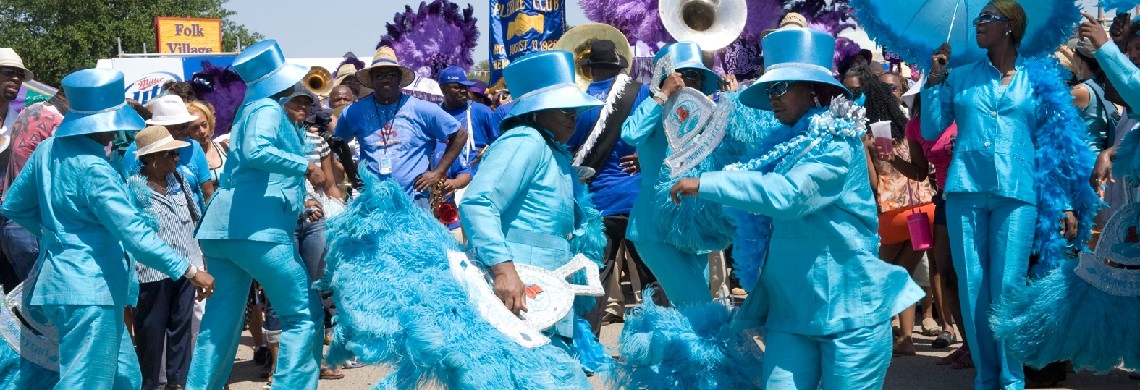Twice each day at the New Orleans Jazz and Heritage Festival, the horns of a brass band blare, the seas of people part, and brilliant colors flash as a social aid and pleasure club begins to proceed around the fairgrounds. Dancing club members steal the scene, drawing the eyes of festivalgoers away from the stages as they recreate the sounds and sights of a New Orleans second line parade.
From the beginning, Jazz Fest—originally called the New Orleans Jazz Festival and Louisiana Heritage Fair—sought to honor the “heritage” part of its title by including local bearers of Black New Orleans culture and highlighting local traditions that had been integral to the birth of jazz. Organizer George Wein, who also founded the Newport Jazz Festival, tapped two young jazz archivists, Quint Davis and Allison Miner, who worked for Richard B. Allen at the Tulane Jazz Archive, to recruit local groups that represented the full history of New Orleans music. As Davis said, “Really the name is backwards—it should be the Heritage of Jazz Festival.”
In just two years, the festival outgrew its original home in Beauregard Square (now named Louis Armstrong Park). The move to the New Orleans Fair Grounds in 1972 presented festival organizers with new opportunities for including local cultural groups—namely, its social aid and pleasure clubs. The city’s Mardi Gras Indians have performed at the festival since its first year, but organizers realized no portrait of New Orleans’s music culture would be complete without the social aid and pleasure clubs. “The real taproots of the jazz street culture are the Mardi Gras Indians and the jazz procession, whether it is for funerals or second line parades,” Davis said.
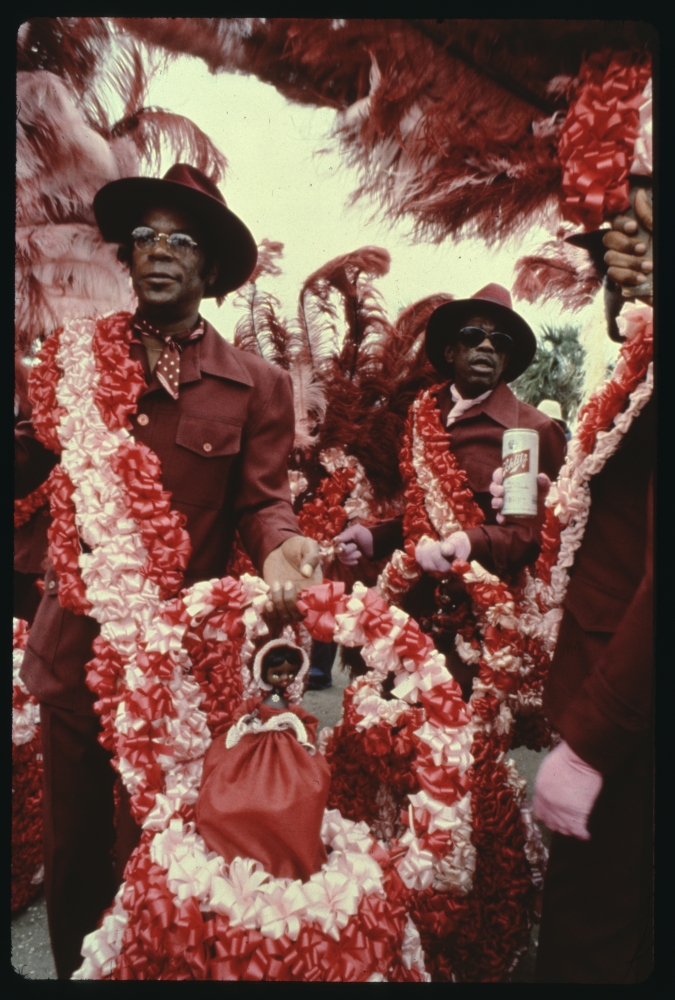
Monk Boudreaux (front) is known as a Mardi Gras Indian big chief, but here he is seen representing the Young Men Olympian Jr. Benevolent Association at the 1980 New Orleans Jazz and Heritage Festival. He and Johnny Tobias (back) were both members; they sported maroon leisure jackets and stylish ties sans collars for their turn around the fairgrounds. (THNOC, photograph by Michael P. Smith © The Historic New Orleans Collection, 2007.0103.8.1602)
Davis met with Alfred “Bucket” Carter and Norman Dixon Sr., both longtime members of the Young Men Olympian Junior Benevolent Association, the city’s oldest Black parading organization still in existence, to discuss having second line parades at the Fest. An agreement was reached, and Dixon was tapped to organize the parades.
Because Dixon drove all over town as a deliveryman, he was able to stop at the club members’ homes to sign them up. In 1975, the YMO Jr. became the first club to parade at Jazz Fest. The next year, the Scene Boosters made their debut at the festival. The club was founded in 1973 by Baptiste Giles and Percy Lewis, big chief of the Black Eagles Mardi Gras Indians. The festival had expanded to two weekends at that point, so the YMO Jr. and the Scene Boosters alternated weekends, holding one parade a day, an arrangement that continued for three years.
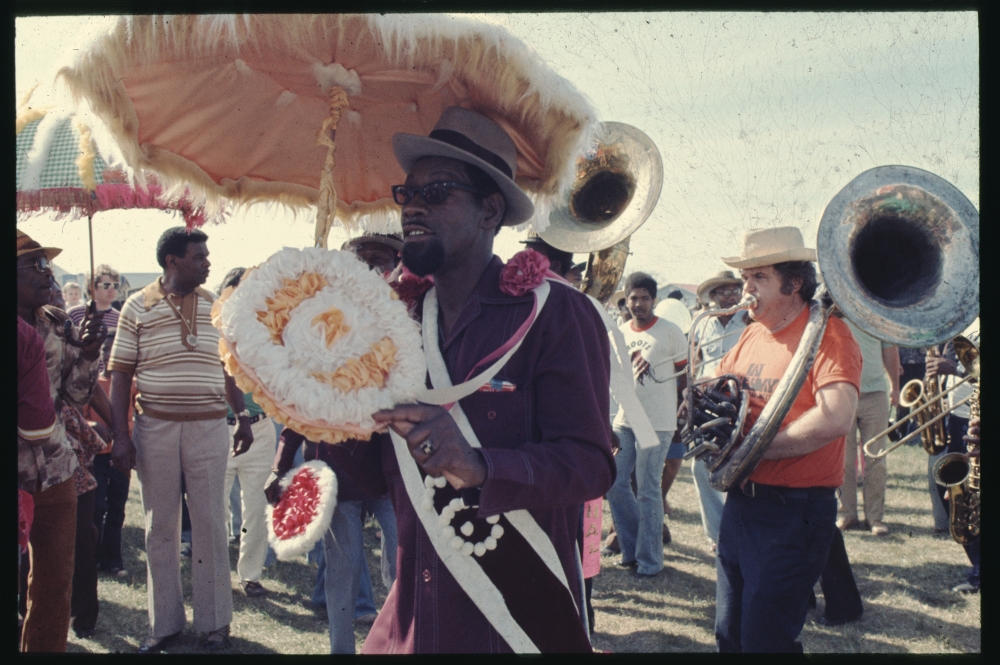
Norman Dixon Sr., seen here in 1980, organized Jazz Fest’s social aid and pleasure clubs parades for decades. After his death, in 2004, the festival held one of the largest memorial parades in its history. Here Dixon can be seen parading with the Young Men Olympian Jr., the city’s oldest surviving Black parading club and the first club to parade at Jazz Fest. (THNOC, photograph by Michael P. Smith © The Historic New Orleans Collection, 2007.0103.8.317)
Building the Cultural Economy
The exposure that Jazz Fest provided for the clubs was part of a larger transition in the city’s economy toward tourism over the course of the 1970s and ’80s. To a national audience, Jazz Fest presented the clubs reverently as “living ethnological exhibits,” or “living exhibitions,” according to Helen A. Regis and Shana Watson in their groundbreaking 2008 study, “Producing the Folk in the New Orleans Jazz and Heritage Festival.” New Orleans was well on its way to building what is now known as the cultural economy, and because of Jazz Fest’s role as “gatekeeper to larger markets . . . consequently (almost inevitably) it exerts a magnetic or even a distorting effect on local music and community traditions.”
One effect of this influence is suggested by the number of clubs that cropped up parallel to the growth of Jazz Fest, including the Fun Lovers (1973), a ladies’ club that paraded with the Scene Boosters; the Money Wasters (1974), one of the largest downtown clubs; Kool and the Gang (1975), which paraded as a kids’ division of the Scene Boosters; and the Original Four (1979), which started as a division of the YMO Jr.
In 1979, the number of clubs participating in Jazz Fest expanded to seven, adding the Fun Lovers, Theme Boosters, Money Wasters, and two recently formed ladies’ groups—the Burgundy Ladies and the Calendar Girls. In response to all the new clubs, Jazz Fest expanded its parade roster, adding new groups every year of the 1980s, so that, by the 1990s, multiple clubs were parading two or three times per day of the festival.
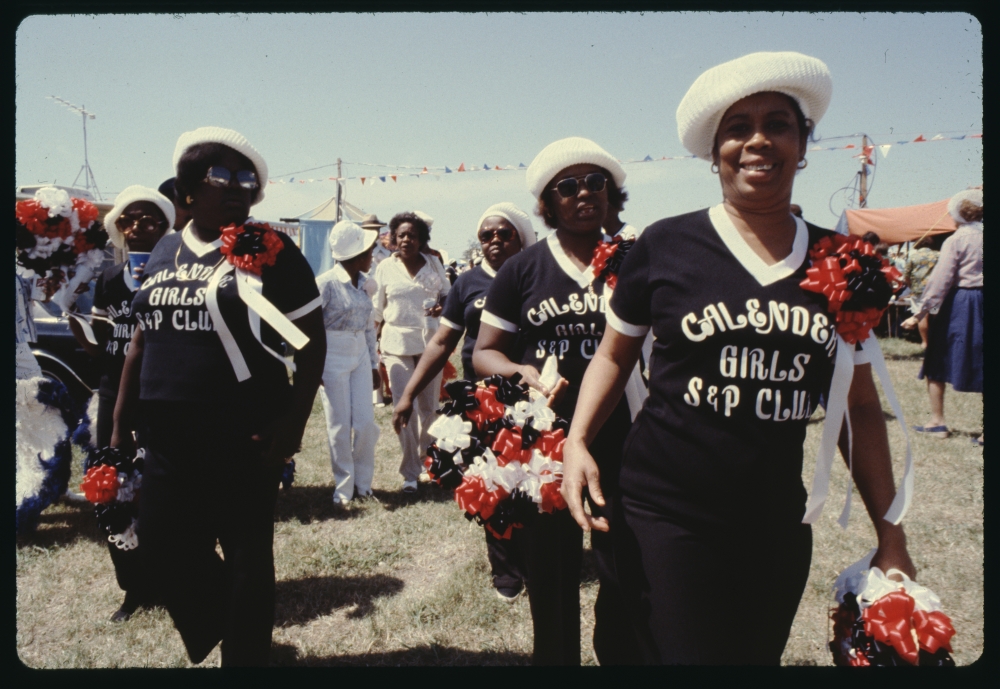
The Calendar Girls, seen here at Jazz Fest 1979, were one of several women’s clubs to form in the late 1970s. (THNOC, photograph by Michael P. Smith © The Historic New Orleans Collection, 2007.0103.8.364)
This increase in national and international attention also led to lucrative performance contracts, both domestically and abroad. In 1976 the Scene Boosters were invited to Washington, DC, to perform at the Festival of American Folklife (now known as the Smithsonian Folklife Festival). Wardell Lewis Sr., founder of the Scene Highlighters, the Nkrumah Better Boys, and the Buckjumpers, which all paraded at Jazz Fest, said he has performed in Ireland, France, and Portugal through his SAPC (social aid and pleasure club) and Jazz Fest affiliations. Linda Porter, president of the Lady Buckjumpers, said that her club has traveled often with the Rebirth Brass Band, to places such as New York, Baltimore, and Germany. In addition, the money that clubs receive as compensation for their Jazz Fest performances helps to offset the high cost of putting on their annual parades.
Turning the Second Line into a Circle
During the fest, clubs are given a tent where members can change into their outfits—the same ones they wear for their regular Sunday street parades, complete with colorful suits, hats, shoes, streamers, umbrellas, and fans. At the appointed time, they gather at the starting point with a band, and when the tuba gives the four-note call, they jump into action, waving their fans, and dancing high and low along the paths that wind through the infield of the fairgrounds. The crowds part to let them through; for many attendees, including locals, it is their first time experiencing New Orleans’s second line tradition. Just as in their regular parades, the dancers sometimes pause their forward movement, throw their fans or hats on the ground, and perform elaborate dance steps in a circle. Each parade lasts about half an hour and makes a complete circle of the infield before disbanding at the point where it started.
With the proliferation of clubs participating in Jazz Fest, certain rules have been established. For example, to ensure that clubs are legitimate outfits and not pick-up groups formed specifically to get paid by Jazz Fest, a club must have had a regular parade on the street for two years before being eligible to appear at the festival.
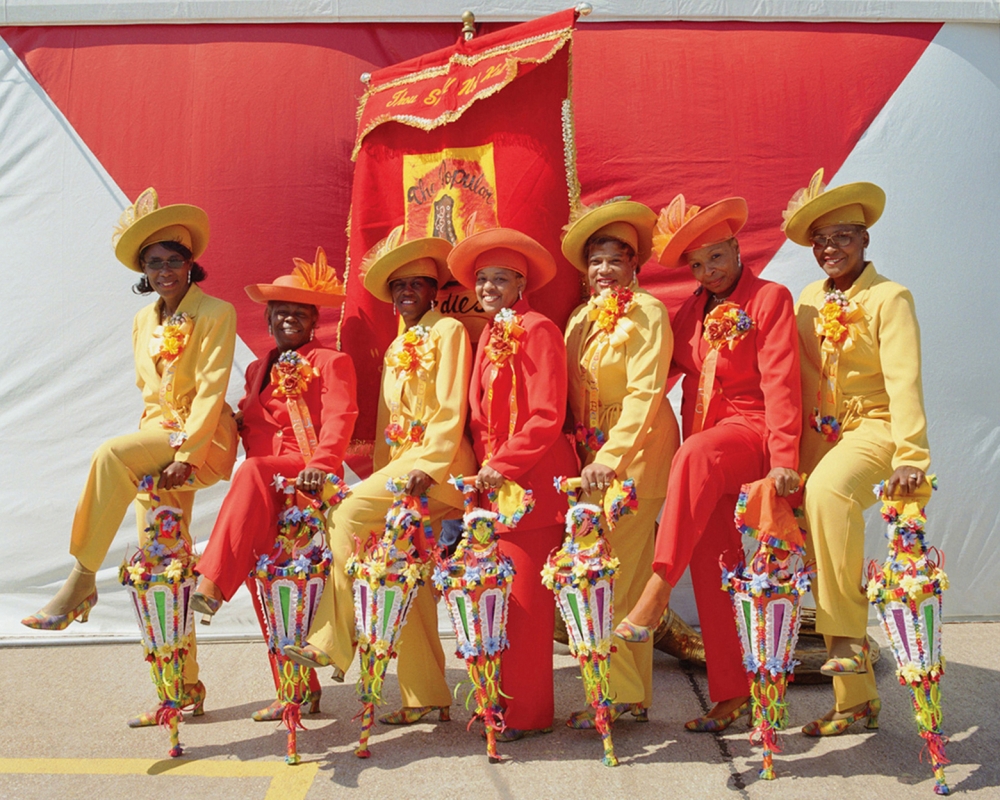
The Popular Ladies strike a pose outside the social aid and pleasure club prep tent at Jazz Fest ca. 1999 (Photograph courtesy of Judy Cooper)
Over the years, Jazz Fest has continued to show its dedication to the city’s SAPCs. In 1994, it established what is now called the Norman Dixon Sr. Annual Second Line Parade Fund, to help pay for the police details at the clubs’ anniversary parades. The Jazz and Heritage Foundation and Quint Davis’s Festival Productions Inc. are the major contributors to the nonprofit fund, but donations come from other individuals and organizations. After Katrina, the festival introduced a new stage, the Jazz and Heritage Stage, to highlight local brass bands, Mardi Gras Indians, and SAPCs.
As an important part of jazz history, funeral parades have been incorporated into the programming of the festival. When a musician, artist, or club member important to the festival dies, he or she is given a jazz funeral at the Fest. Family and friends of the deceased function as the first line, often carrying large photographs of the deceased at the head of the parade, followed by the clubs and the band. As in a regular funeral parade, a crowd of Fest attendees follows along behind. The procession marches in slow cadence to the “ancestor spot,” an area near the Congo Square Stage featuring larger-than-life likenesses of many important “ancestors” of the festival. A statue of the newly deceased is unveiled, speeches are made, and the parade then second lines through the infield. One of the largest of these Jazz Fest funeral parades honored Norman Dixon Sr., in 2004. And in 2022, both weekends of the festival will feature a procession for founder George Wein, who passed away on September 13, 2021, at the age of 95.
This article is an adapted excerpt from THNOC’s 2021 book Dancing in the Streets: Social Aid and Pleasure Clubs of New Orleans. To learn more about the social aid and pleasure clubs of New Orleans, visit this assortment of resources.
Banner image: Lady Buckjumpers at Jazz Fest, 2008, by Judy Cooper (Courtesy of Judy Cooper)

